Business Finance
VerifiedAdded on 2023/06/05
|18
|3054
|348
AI Summary
This article provides an analysis of financial ratios and investment decisions for a company in the business finance sector. It includes a comparison of industry averages, calculation of expected rates of return, payback periods, net present value, internal rate of return, and profitability index.
Contribute Materials
Your contribution can guide someone’s learning journey. Share your
documents today.
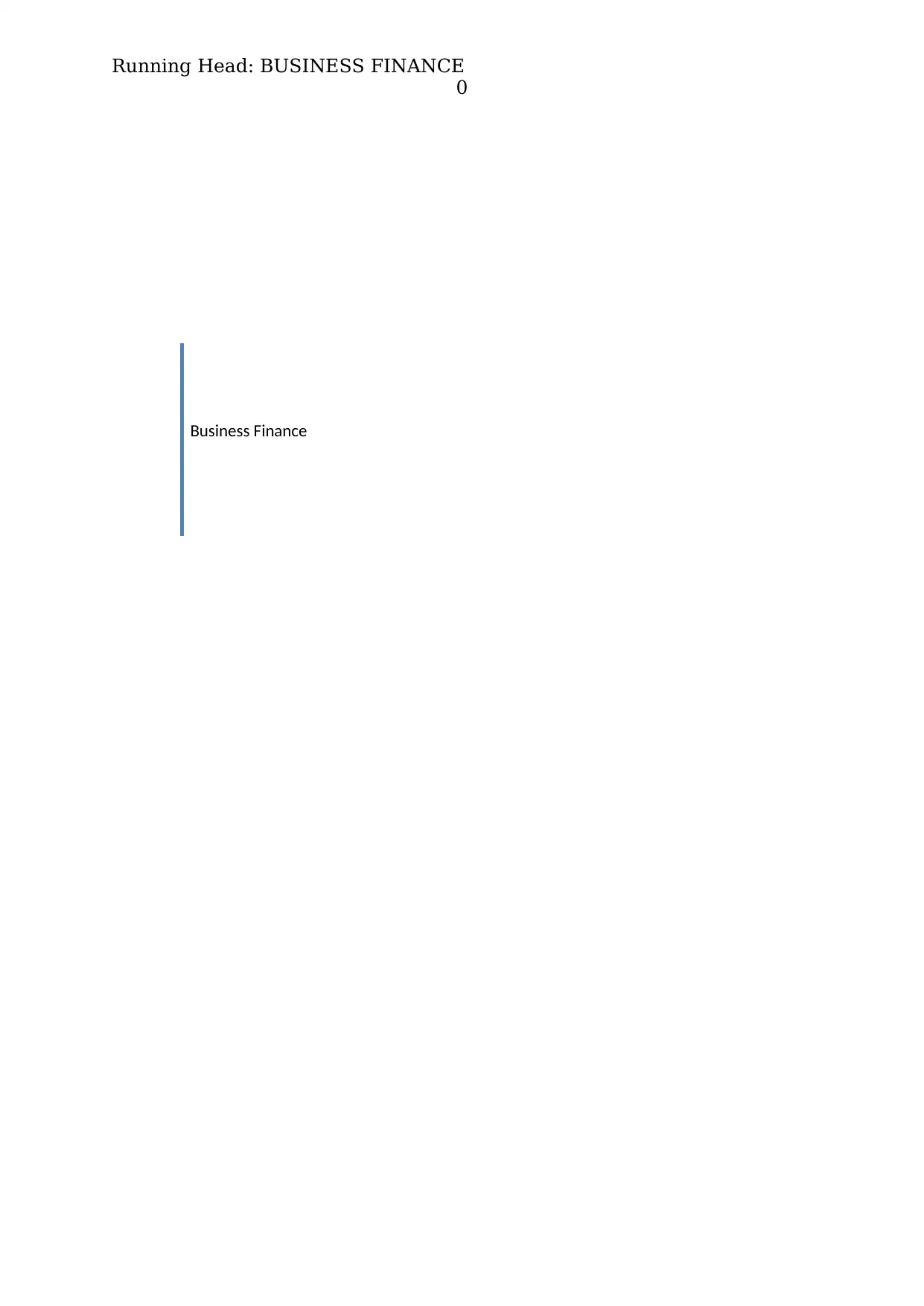
Running Head: BUSINESS FINANCE
0
Business Finance
0
Business Finance
Secure Best Marks with AI Grader
Need help grading? Try our AI Grader for instant feedback on your assignments.
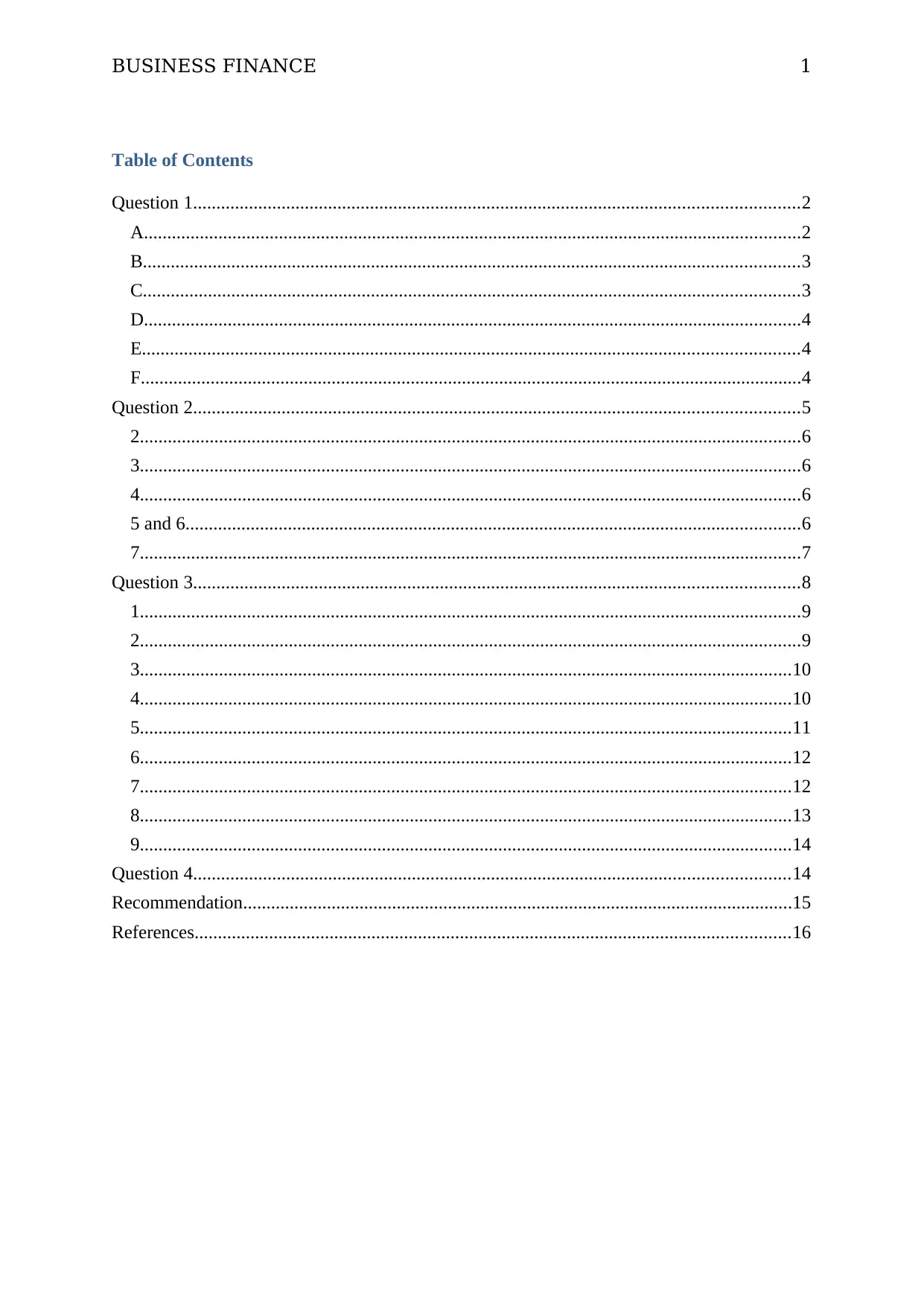
BUSINESS FINANCE 1
Table of Contents
Question 1..................................................................................................................................2
A.............................................................................................................................................2
B.............................................................................................................................................3
C.............................................................................................................................................3
D.............................................................................................................................................4
E.............................................................................................................................................4
F..............................................................................................................................................4
Question 2..................................................................................................................................5
2..............................................................................................................................................6
3..............................................................................................................................................6
4..............................................................................................................................................6
5 and 6....................................................................................................................................6
7..............................................................................................................................................7
Question 3..................................................................................................................................8
1..............................................................................................................................................9
2..............................................................................................................................................9
3............................................................................................................................................10
4............................................................................................................................................10
5............................................................................................................................................11
6............................................................................................................................................12
7............................................................................................................................................12
8............................................................................................................................................13
9............................................................................................................................................14
Question 4................................................................................................................................14
Recommendation......................................................................................................................15
References................................................................................................................................16
Table of Contents
Question 1..................................................................................................................................2
A.............................................................................................................................................2
B.............................................................................................................................................3
C.............................................................................................................................................3
D.............................................................................................................................................4
E.............................................................................................................................................4
F..............................................................................................................................................4
Question 2..................................................................................................................................5
2..............................................................................................................................................6
3..............................................................................................................................................6
4..............................................................................................................................................6
5 and 6....................................................................................................................................6
7..............................................................................................................................................7
Question 3..................................................................................................................................8
1..............................................................................................................................................9
2..............................................................................................................................................9
3............................................................................................................................................10
4............................................................................................................................................10
5............................................................................................................................................11
6............................................................................................................................................12
7............................................................................................................................................12
8............................................................................................................................................13
9............................................................................................................................................14
Question 4................................................................................................................................14
Recommendation......................................................................................................................15
References................................................................................................................................16
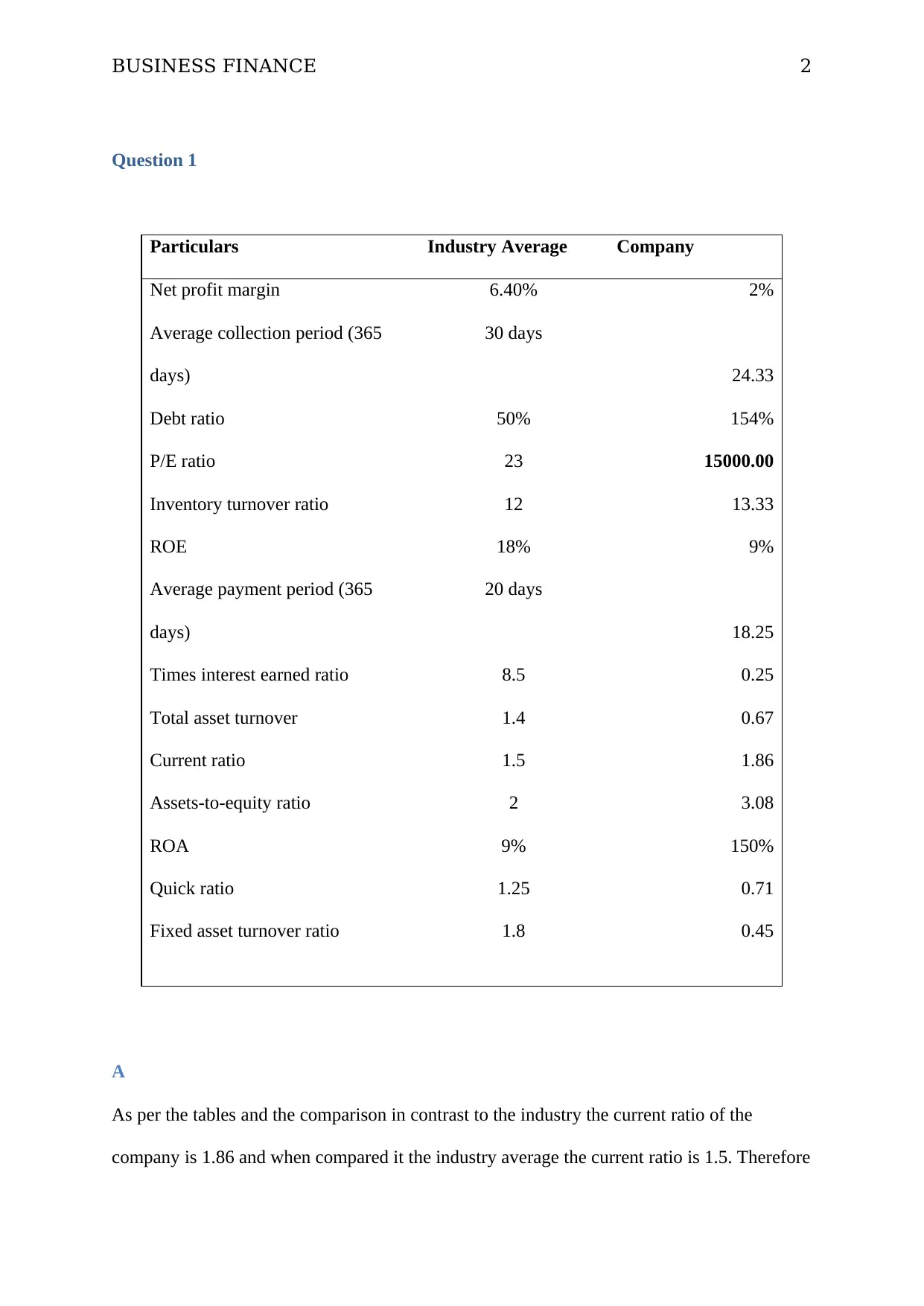
BUSINESS FINANCE 2
Question 1
Particulars Industry Average Company
Net profit margin 6.40% 2%
Average collection period (365
days)
30 days
24.33
Debt ratio 50% 154%
P/E ratio 23 15000.00
Inventory turnover ratio 12 13.33
ROE 18% 9%
Average payment period (365
days)
20 days
18.25
Times interest earned ratio 8.5 0.25
Total asset turnover 1.4 0.67
Current ratio 1.5 1.86
Assets-to-equity ratio 2 3.08
ROA 9% 150%
Quick ratio 1.25 0.71
Fixed asset turnover ratio 1.8 0.45
A
As per the tables and the comparison in contrast to the industry the current ratio of the
company is 1.86 and when compared it the industry average the current ratio is 1.5. Therefore
Question 1
Particulars Industry Average Company
Net profit margin 6.40% 2%
Average collection period (365
days)
30 days
24.33
Debt ratio 50% 154%
P/E ratio 23 15000.00
Inventory turnover ratio 12 13.33
ROE 18% 9%
Average payment period (365
days)
20 days
18.25
Times interest earned ratio 8.5 0.25
Total asset turnover 1.4 0.67
Current ratio 1.5 1.86
Assets-to-equity ratio 2 3.08
ROA 9% 150%
Quick ratio 1.25 0.71
Fixed asset turnover ratio 1.8 0.45
A
As per the tables and the comparison in contrast to the industry the current ratio of the
company is 1.86 and when compared it the industry average the current ratio is 1.5. Therefore
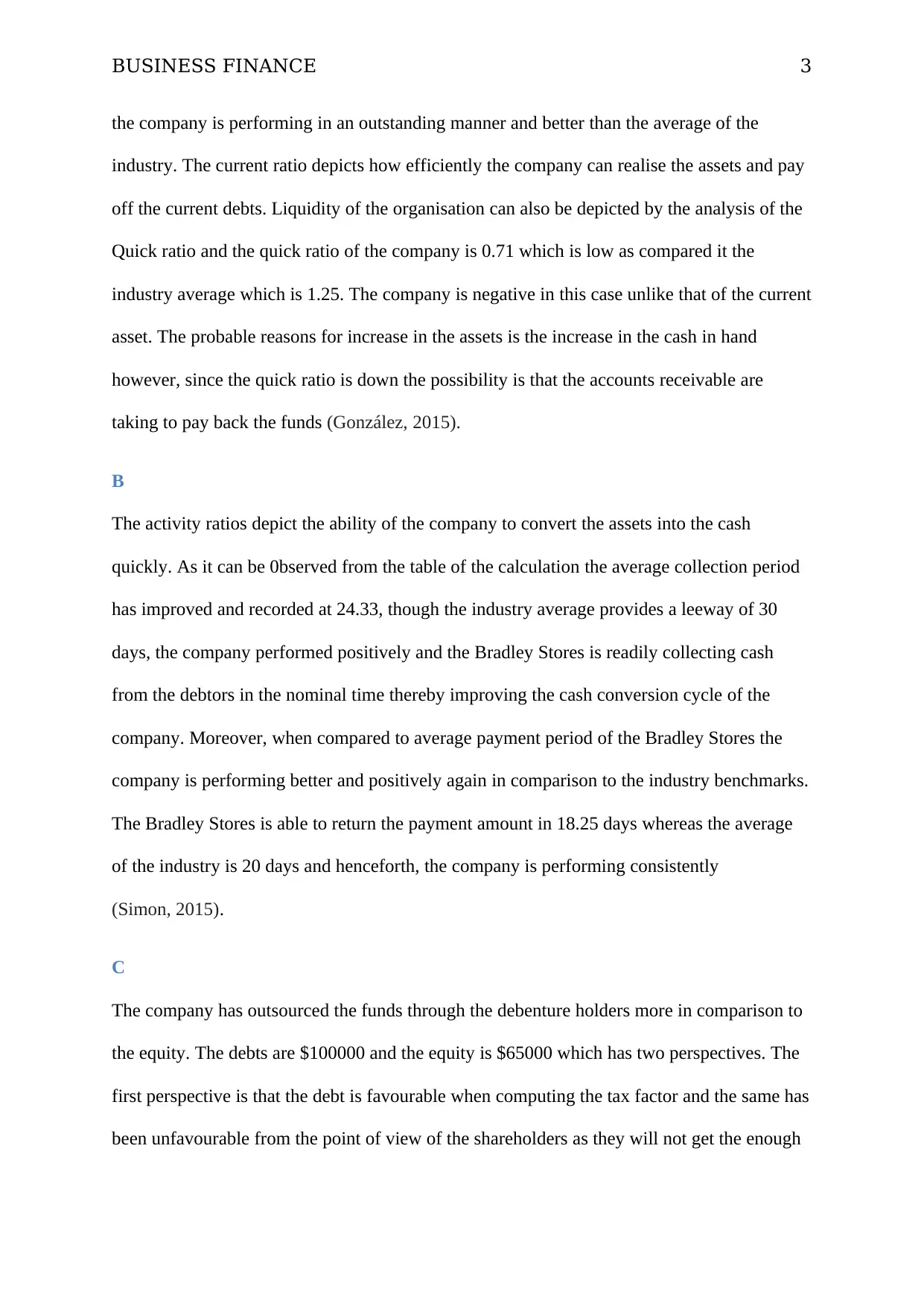
BUSINESS FINANCE 3
the company is performing in an outstanding manner and better than the average of the
industry. The current ratio depicts how efficiently the company can realise the assets and pay
off the current debts. Liquidity of the organisation can also be depicted by the analysis of the
Quick ratio and the quick ratio of the company is 0.71 which is low as compared it the
industry average which is 1.25. The company is negative in this case unlike that of the current
asset. The probable reasons for increase in the assets is the increase in the cash in hand
however, since the quick ratio is down the possibility is that the accounts receivable are
taking to pay back the funds (González, 2015).
B
The activity ratios depict the ability of the company to convert the assets into the cash
quickly. As it can be 0bserved from the table of the calculation the average collection period
has improved and recorded at 24.33, though the industry average provides a leeway of 30
days, the company performed positively and the Bradley Stores is readily collecting cash
from the debtors in the nominal time thereby improving the cash conversion cycle of the
company. Moreover, when compared to average payment period of the Bradley Stores the
company is performing better and positively again in comparison to the industry benchmarks.
The Bradley Stores is able to return the payment amount in 18.25 days whereas the average
of the industry is 20 days and henceforth, the company is performing consistently
(Simon, 2015).
C
The company has outsourced the funds through the debenture holders more in comparison to
the equity. The debts are $100000 and the equity is $65000 which has two perspectives. The
first perspective is that the debt is favourable when computing the tax factor and the same has
been unfavourable from the point of view of the shareholders as they will not get the enough
the company is performing in an outstanding manner and better than the average of the
industry. The current ratio depicts how efficiently the company can realise the assets and pay
off the current debts. Liquidity of the organisation can also be depicted by the analysis of the
Quick ratio and the quick ratio of the company is 0.71 which is low as compared it the
industry average which is 1.25. The company is negative in this case unlike that of the current
asset. The probable reasons for increase in the assets is the increase in the cash in hand
however, since the quick ratio is down the possibility is that the accounts receivable are
taking to pay back the funds (González, 2015).
B
The activity ratios depict the ability of the company to convert the assets into the cash
quickly. As it can be 0bserved from the table of the calculation the average collection period
has improved and recorded at 24.33, though the industry average provides a leeway of 30
days, the company performed positively and the Bradley Stores is readily collecting cash
from the debtors in the nominal time thereby improving the cash conversion cycle of the
company. Moreover, when compared to average payment period of the Bradley Stores the
company is performing better and positively again in comparison to the industry benchmarks.
The Bradley Stores is able to return the payment amount in 18.25 days whereas the average
of the industry is 20 days and henceforth, the company is performing consistently
(Simon, 2015).
C
The company has outsourced the funds through the debenture holders more in comparison to
the equity. The debts are $100000 and the equity is $65000 which has two perspectives. The
first perspective is that the debt is favourable when computing the tax factor and the same has
been unfavourable from the point of view of the shareholders as they will not get the enough
Secure Best Marks with AI Grader
Need help grading? Try our AI Grader for instant feedback on your assignments.
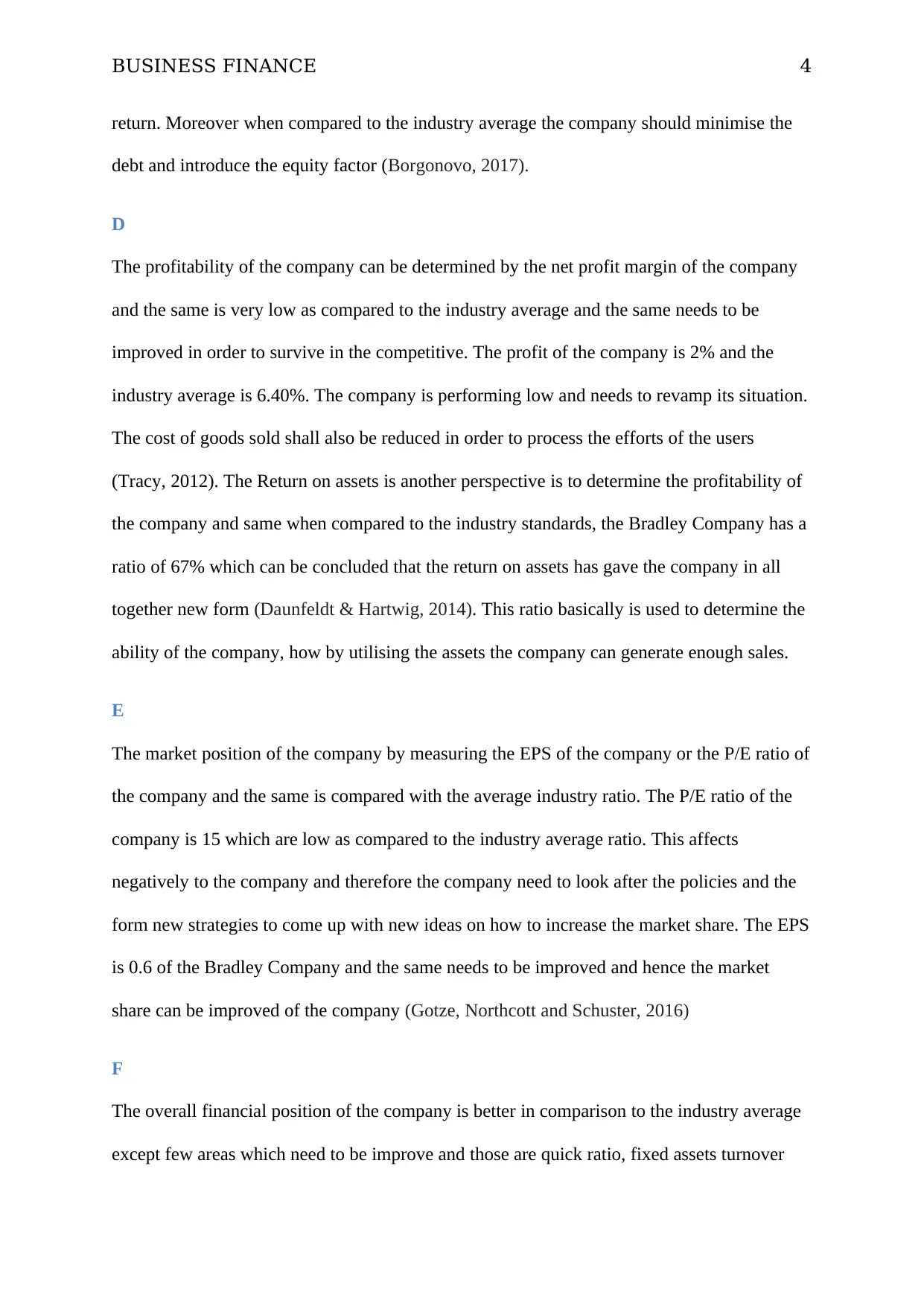
BUSINESS FINANCE 4
return. Moreover when compared to the industry average the company should minimise the
debt and introduce the equity factor (Borgonovo, 2017).
D
The profitability of the company can be determined by the net profit margin of the company
and the same is very low as compared to the industry average and the same needs to be
improved in order to survive in the competitive. The profit of the company is 2% and the
industry average is 6.40%. The company is performing low and needs to revamp its situation.
The cost of goods sold shall also be reduced in order to process the efforts of the users
(Tracy, 2012). The Return on assets is another perspective is to determine the profitability of
the company and same when compared to the industry standards, the Bradley Company has a
ratio of 67% which can be concluded that the return on assets has gave the company in all
together new form (Daunfeldt & Hartwig, 2014). This ratio basically is used to determine the
ability of the company, how by utilising the assets the company can generate enough sales.
E
The market position of the company by measuring the EPS of the company or the P/E ratio of
the company and the same is compared with the average industry ratio. The P/E ratio of the
company is 15 which are low as compared to the industry average ratio. This affects
negatively to the company and therefore the company need to look after the policies and the
form new strategies to come up with new ideas on how to increase the market share. The EPS
is 0.6 of the Bradley Company and the same needs to be improved and hence the market
share can be improved of the company (Gotze, Northcott and Schuster, 2016)
F
The overall financial position of the company is better in comparison to the industry average
except few areas which need to be improve and those are quick ratio, fixed assets turnover
return. Moreover when compared to the industry average the company should minimise the
debt and introduce the equity factor (Borgonovo, 2017).
D
The profitability of the company can be determined by the net profit margin of the company
and the same is very low as compared to the industry average and the same needs to be
improved in order to survive in the competitive. The profit of the company is 2% and the
industry average is 6.40%. The company is performing low and needs to revamp its situation.
The cost of goods sold shall also be reduced in order to process the efforts of the users
(Tracy, 2012). The Return on assets is another perspective is to determine the profitability of
the company and same when compared to the industry standards, the Bradley Company has a
ratio of 67% which can be concluded that the return on assets has gave the company in all
together new form (Daunfeldt & Hartwig, 2014). This ratio basically is used to determine the
ability of the company, how by utilising the assets the company can generate enough sales.
E
The market position of the company by measuring the EPS of the company or the P/E ratio of
the company and the same is compared with the average industry ratio. The P/E ratio of the
company is 15 which are low as compared to the industry average ratio. This affects
negatively to the company and therefore the company need to look after the policies and the
form new strategies to come up with new ideas on how to increase the market share. The EPS
is 0.6 of the Bradley Company and the same needs to be improved and hence the market
share can be improved of the company (Gotze, Northcott and Schuster, 2016)
F
The overall financial position of the company is better in comparison to the industry average
except few areas which need to be improve and those are quick ratio, fixed assets turnover
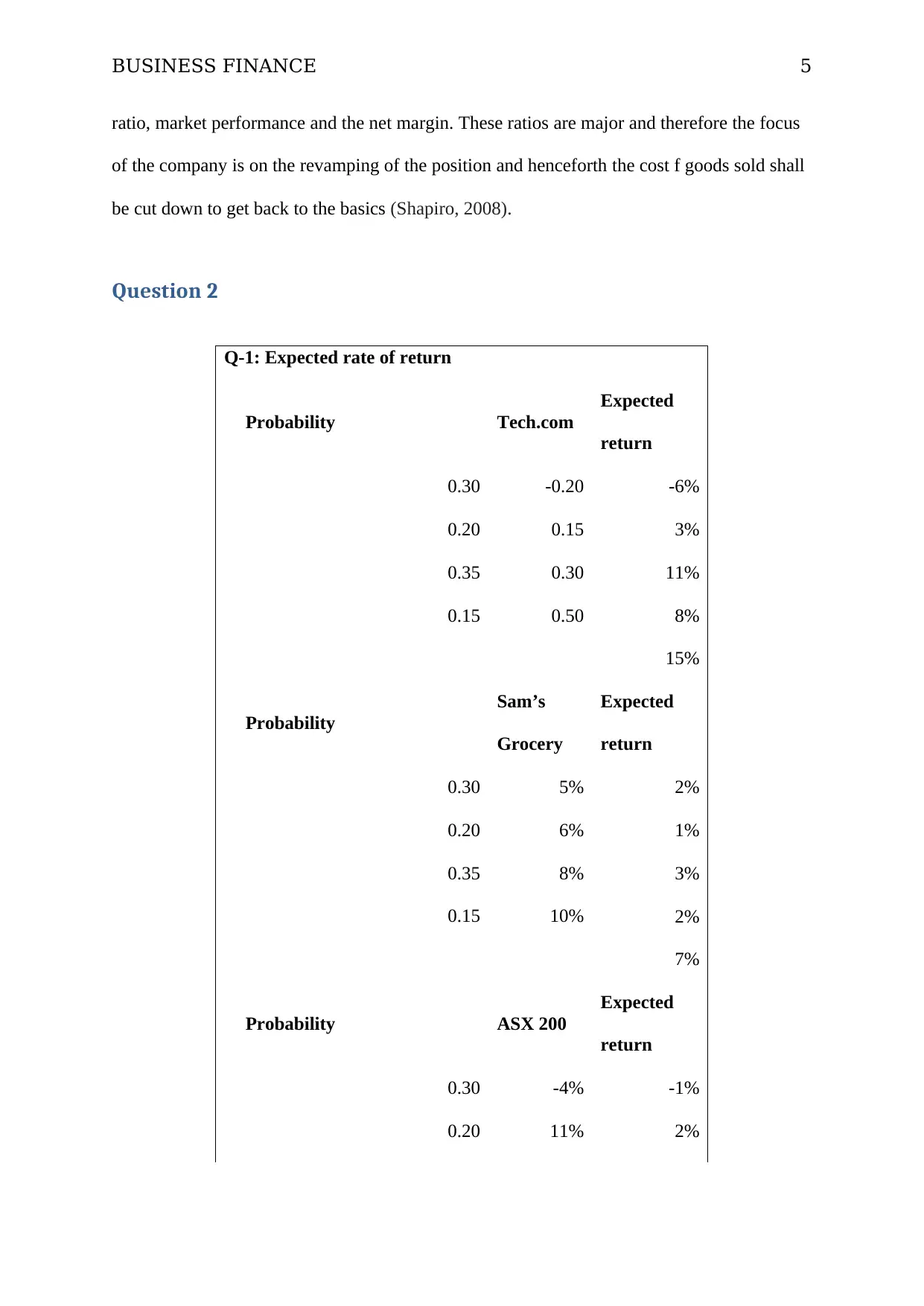
BUSINESS FINANCE 5
ratio, market performance and the net margin. These ratios are major and therefore the focus
of the company is on the revamping of the position and henceforth the cost f goods sold shall
be cut down to get back to the basics (Shapiro, 2008).
Question 2
Q-1: Expected rate of return
Probability Tech.com
Expected
return
0.30 -0.20 -6%
0.20 0.15 3%
0.35 0.30 11%
0.15 0.50 8%
15%
Probability
Sam’s
Grocery
Expected
return
0.30 5% 2%
0.20 6% 1%
0.35 8% 3%
0.15 10% 2%
7%
Probability ASX 200
Expected
return
0.30 -4% -1%
0.20 11% 2%
ratio, market performance and the net margin. These ratios are major and therefore the focus
of the company is on the revamping of the position and henceforth the cost f goods sold shall
be cut down to get back to the basics (Shapiro, 2008).
Question 2
Q-1: Expected rate of return
Probability Tech.com
Expected
return
0.30 -0.20 -6%
0.20 0.15 3%
0.35 0.30 11%
0.15 0.50 8%
15%
Probability
Sam’s
Grocery
Expected
return
0.30 5% 2%
0.20 6% 1%
0.35 8% 3%
0.15 10% 2%
7%
Probability ASX 200
Expected
return
0.30 -4% -1%
0.20 11% 2%
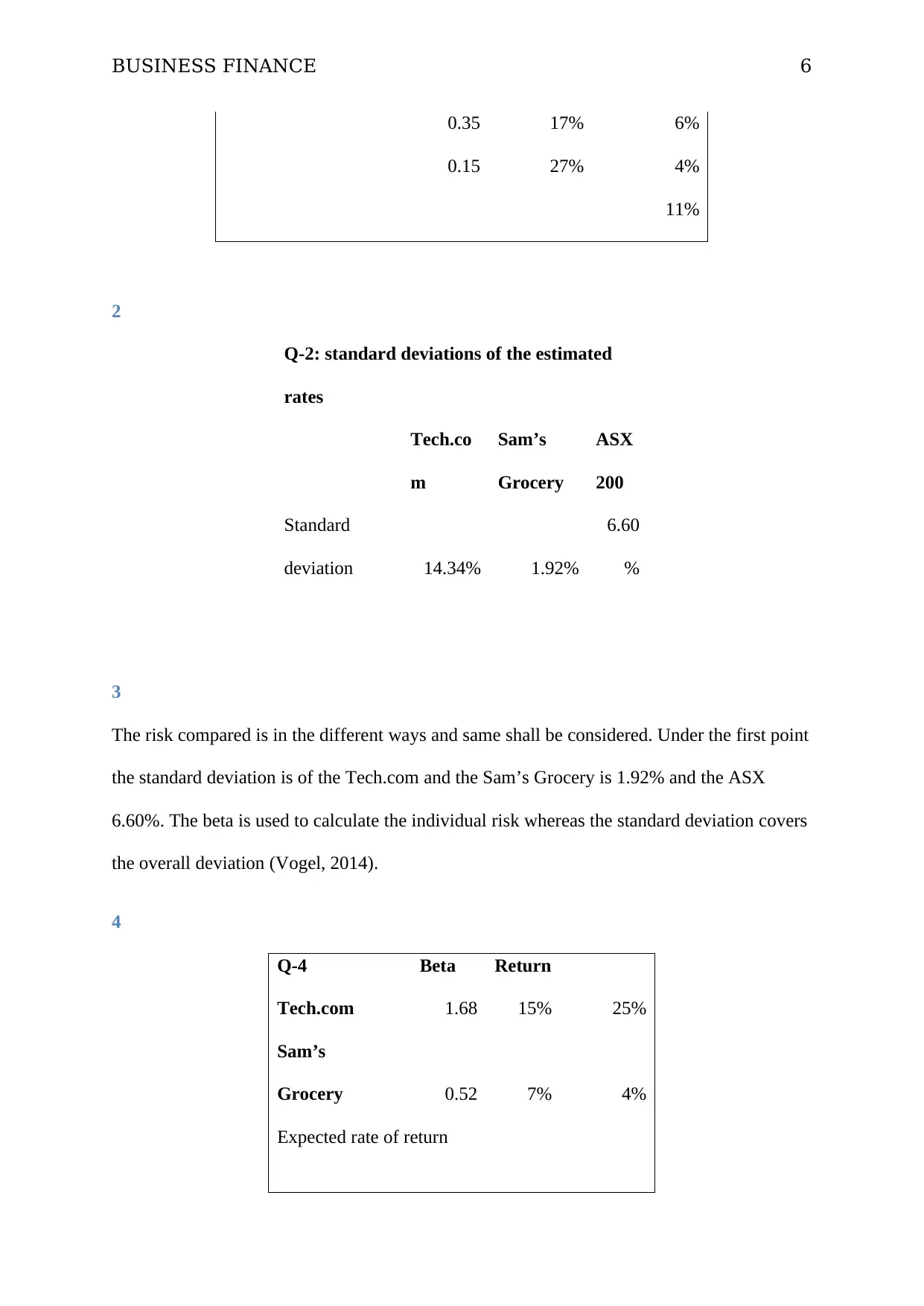
BUSINESS FINANCE 6
0.35 17% 6%
0.15 27% 4%
11%
2
Q-2: standard deviations of the estimated
rates
Tech.co
m
Sam’s
Grocery
ASX
200
Standard
deviation 14.34% 1.92%
6.60
%
3
The risk compared is in the different ways and same shall be considered. Under the first point
the standard deviation is of the Tech.com and the Sam’s Grocery is 1.92% and the ASX
6.60%. The beta is used to calculate the individual risk whereas the standard deviation covers
the overall deviation (Vogel, 2014).
4
Q-4 Beta Return
Tech.com 1.68 15% 25%
Sam’s
Grocery 0.52 7% 4%
Expected rate of return
0.35 17% 6%
0.15 27% 4%
11%
2
Q-2: standard deviations of the estimated
rates
Tech.co
m
Sam’s
Grocery
ASX
200
Standard
deviation 14.34% 1.92%
6.60
%
3
The risk compared is in the different ways and same shall be considered. Under the first point
the standard deviation is of the Tech.com and the Sam’s Grocery is 1.92% and the ASX
6.60%. The beta is used to calculate the individual risk whereas the standard deviation covers
the overall deviation (Vogel, 2014).
4
Q-4 Beta Return
Tech.com 1.68 15% 25%
Sam’s
Grocery 0.52 7% 4%
Expected rate of return
Paraphrase This Document
Need a fresh take? Get an instant paraphrase of this document with our AI Paraphraser
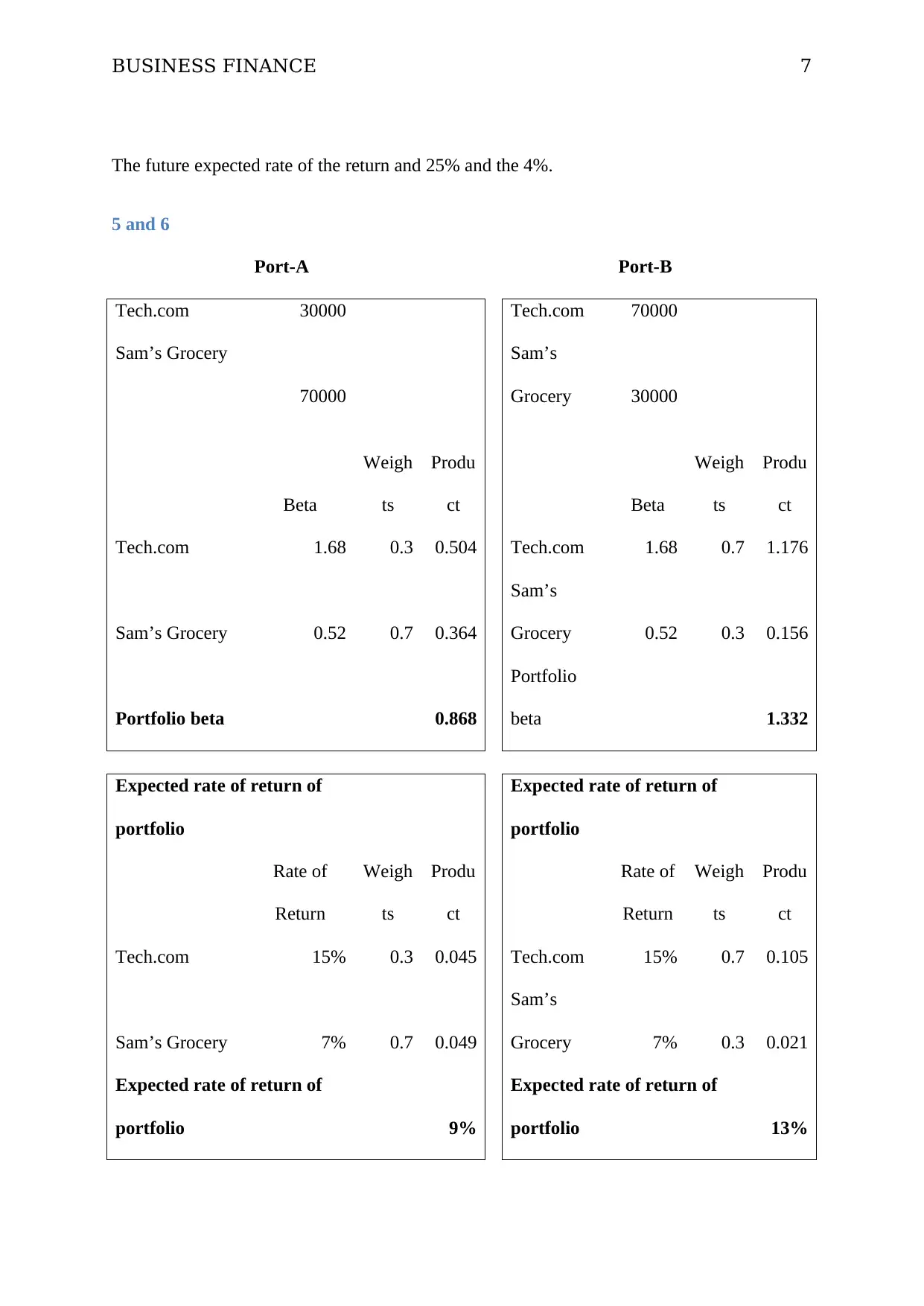
BUSINESS FINANCE 7
The future expected rate of the return and 25% and the 4%.
5 and 6
Port-A Port-B
Tech.com 30000 Tech.com 70000
Sam’s Grocery
70000
Sam’s
Grocery 30000
Beta
Weigh
ts
Produ
ct Beta
Weigh
ts
Produ
ct
Tech.com 1.68 0.3 0.504 Tech.com 1.68 0.7 1.176
Sam’s Grocery 0.52 0.7 0.364
Sam’s
Grocery 0.52 0.3 0.156
Portfolio beta 0.868
Portfolio
beta 1.332
Expected rate of return of
portfolio
Expected rate of return of
portfolio
Rate of
Return
Weigh
ts
Produ
ct
Rate of
Return
Weigh
ts
Produ
ct
Tech.com 15% 0.3 0.045 Tech.com 15% 0.7 0.105
Sam’s Grocery 7% 0.7 0.049
Sam’s
Grocery 7% 0.3 0.021
Expected rate of return of
portfolio 9%
Expected rate of return of
portfolio 13%
The future expected rate of the return and 25% and the 4%.
5 and 6
Port-A Port-B
Tech.com 30000 Tech.com 70000
Sam’s Grocery
70000
Sam’s
Grocery 30000
Beta
Weigh
ts
Produ
ct Beta
Weigh
ts
Produ
ct
Tech.com 1.68 0.3 0.504 Tech.com 1.68 0.7 1.176
Sam’s Grocery 0.52 0.7 0.364
Sam’s
Grocery 0.52 0.3 0.156
Portfolio beta 0.868
Portfolio
beta 1.332
Expected rate of return of
portfolio
Expected rate of return of
portfolio
Rate of
Return
Weigh
ts
Produ
ct
Rate of
Return
Weigh
ts
Produ
ct
Tech.com 15% 0.3 0.045 Tech.com 15% 0.7 0.105
Sam’s Grocery 7% 0.7 0.049
Sam’s
Grocery 7% 0.3 0.021
Expected rate of return of
portfolio 9%
Expected rate of return of
portfolio 13%
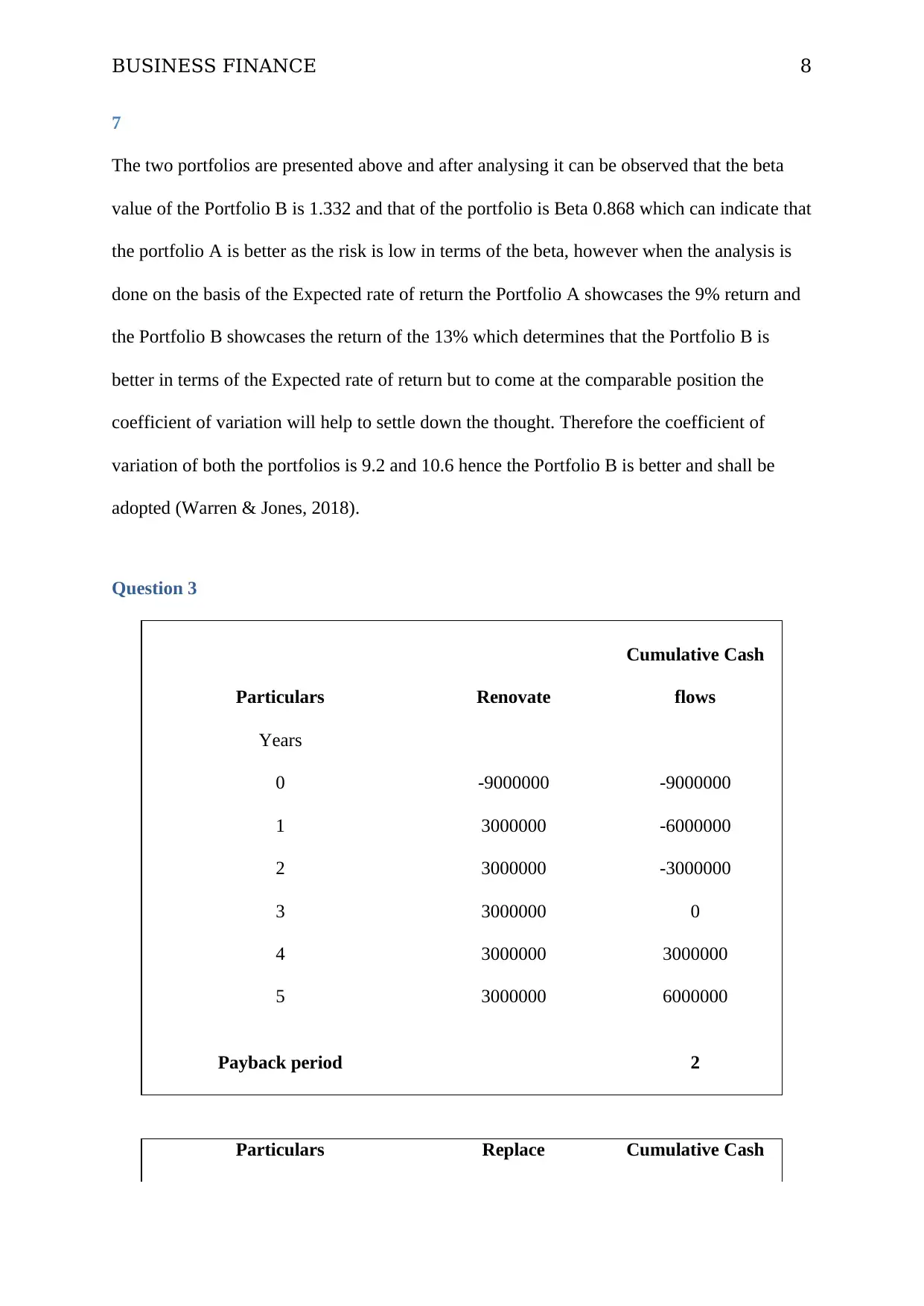
BUSINESS FINANCE 8
7
The two portfolios are presented above and after analysing it can be observed that the beta
value of the Portfolio B is 1.332 and that of the portfolio is Beta 0.868 which can indicate that
the portfolio A is better as the risk is low in terms of the beta, however when the analysis is
done on the basis of the Expected rate of return the Portfolio A showcases the 9% return and
the Portfolio B showcases the return of the 13% which determines that the Portfolio B is
better in terms of the Expected rate of return but to come at the comparable position the
coefficient of variation will help to settle down the thought. Therefore the coefficient of
variation of both the portfolios is 9.2 and 10.6 hence the Portfolio B is better and shall be
adopted (Warren & Jones, 2018).
Question 3
Particulars Renovate
Cumulative Cash
flows
Years
0 -9000000 -9000000
1 3000000 -6000000
2 3000000 -3000000
3 3000000 0
4 3000000 3000000
5 3000000 6000000
Payback period 2
Particulars Replace Cumulative Cash
7
The two portfolios are presented above and after analysing it can be observed that the beta
value of the Portfolio B is 1.332 and that of the portfolio is Beta 0.868 which can indicate that
the portfolio A is better as the risk is low in terms of the beta, however when the analysis is
done on the basis of the Expected rate of return the Portfolio A showcases the 9% return and
the Portfolio B showcases the return of the 13% which determines that the Portfolio B is
better in terms of the Expected rate of return but to come at the comparable position the
coefficient of variation will help to settle down the thought. Therefore the coefficient of
variation of both the portfolios is 9.2 and 10.6 hence the Portfolio B is better and shall be
adopted (Warren & Jones, 2018).
Question 3
Particulars Renovate
Cumulative Cash
flows
Years
0 -9000000 -9000000
1 3000000 -6000000
2 3000000 -3000000
3 3000000 0
4 3000000 3000000
5 3000000 6000000
Payback period 2
Particulars Replace Cumulative Cash

BUSINESS FINANCE 9
flows
Years
0 -2400000 -2400000
1 2000000 -400000
2 800000 400000
3 200000 600000
4 200000 800000
5 200000 1000000
Payback period 1.5
1
The payback period of the Replace is 1.5 and payback period of the Renovate is 2 therefore
the replace project is accepted. The payback period of the project determines the feasibility
and the longevity of the project and how much time the project will return the investment
efforts made on it (Warren, Reeve & Duchac, 2011).
2
Year
s
Renovate
Rate 15% NPV
0 -9000000 1 -9000000
1 3000000 0.870 2608696
2 3000000 0.756 2268431
3 3000000 0.658 1972549
4 3000000 0.572 1715260
5 3000000 0.497 1491530
1056465
Year
s
Replace
Rate 15% NPV
flows
Years
0 -2400000 -2400000
1 2000000 -400000
2 800000 400000
3 200000 600000
4 200000 800000
5 200000 1000000
Payback period 1.5
1
The payback period of the Replace is 1.5 and payback period of the Renovate is 2 therefore
the replace project is accepted. The payback period of the project determines the feasibility
and the longevity of the project and how much time the project will return the investment
efforts made on it (Warren, Reeve & Duchac, 2011).
2
Year
s
Renovate
Rate 15% NPV
0 -9000000 1 -9000000
1 3000000 0.870 2608696
2 3000000 0.756 2268431
3 3000000 0.658 1972549
4 3000000 0.572 1715260
5 3000000 0.497 1491530
1056465
Year
s
Replace
Rate 15% NPV
Secure Best Marks with AI Grader
Need help grading? Try our AI Grader for instant feedback on your assignments.
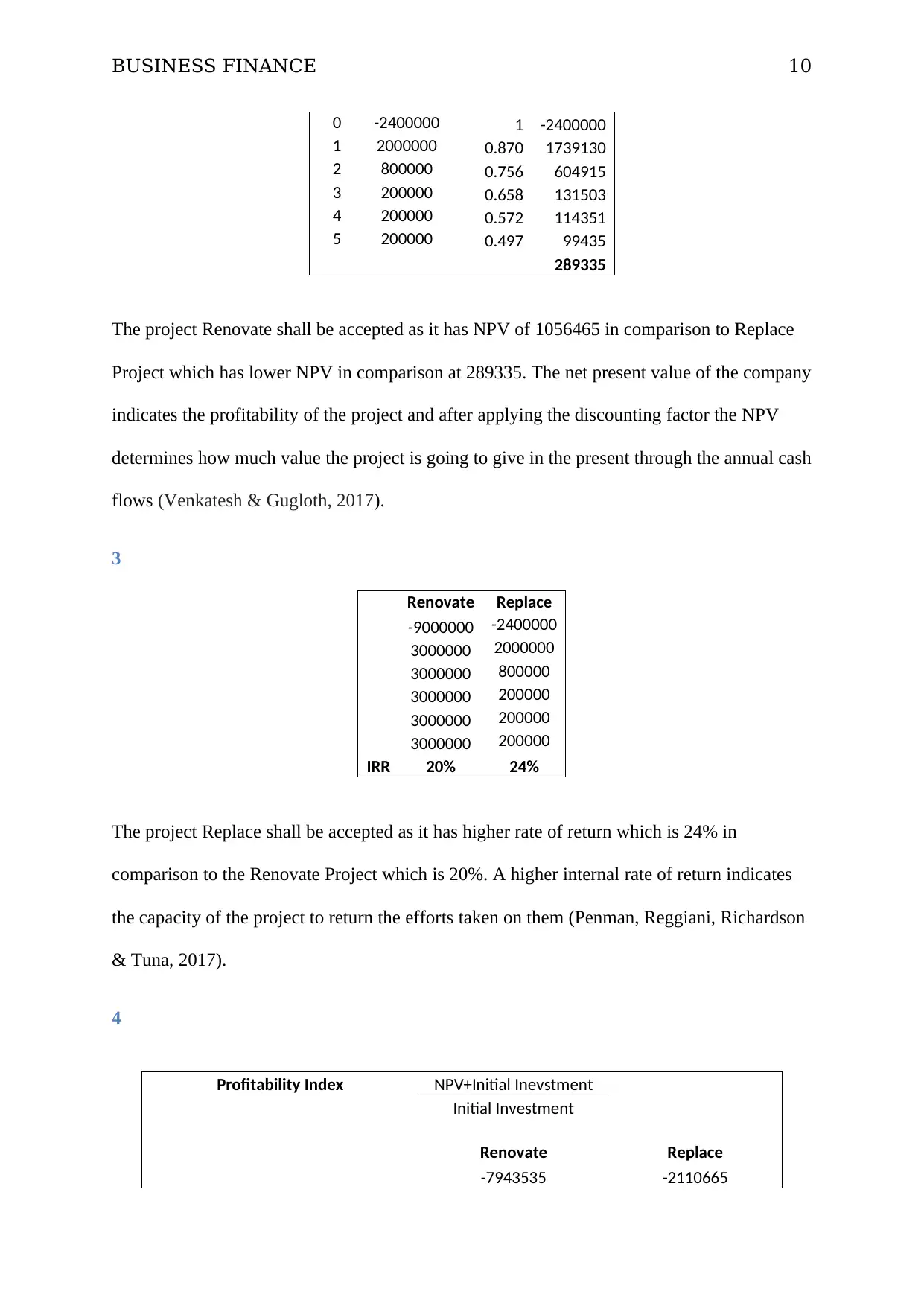
BUSINESS FINANCE 10
0 -2400000 1 -2400000
1 2000000 0.870 1739130
2 800000 0.756 604915
3 200000 0.658 131503
4 200000 0.572 114351
5 200000 0.497 99435
289335
The project Renovate shall be accepted as it has NPV of 1056465 in comparison to Replace
Project which has lower NPV in comparison at 289335. The net present value of the company
indicates the profitability of the project and after applying the discounting factor the NPV
determines how much value the project is going to give in the present through the annual cash
flows (Venkatesh & Gugloth, 2017).
3
Renovate Replace
-9000000 -2400000
3000000 2000000
3000000 800000
3000000 200000
3000000 200000
3000000 200000
IRR 20% 24%
The project Replace shall be accepted as it has higher rate of return which is 24% in
comparison to the Renovate Project which is 20%. A higher internal rate of return indicates
the capacity of the project to return the efforts taken on them (Penman, Reggiani, Richardson
& Tuna, 2017).
4
Profitability Index NPV+Initial Inevstment
Initial Investment
Renovate Replace
-7943535 -2110665
0 -2400000 1 -2400000
1 2000000 0.870 1739130
2 800000 0.756 604915
3 200000 0.658 131503
4 200000 0.572 114351
5 200000 0.497 99435
289335
The project Renovate shall be accepted as it has NPV of 1056465 in comparison to Replace
Project which has lower NPV in comparison at 289335. The net present value of the company
indicates the profitability of the project and after applying the discounting factor the NPV
determines how much value the project is going to give in the present through the annual cash
flows (Venkatesh & Gugloth, 2017).
3
Renovate Replace
-9000000 -2400000
3000000 2000000
3000000 800000
3000000 200000
3000000 200000
3000000 200000
IRR 20% 24%
The project Replace shall be accepted as it has higher rate of return which is 24% in
comparison to the Renovate Project which is 20%. A higher internal rate of return indicates
the capacity of the project to return the efforts taken on them (Penman, Reggiani, Richardson
& Tuna, 2017).
4
Profitability Index NPV+Initial Inevstment
Initial Investment
Renovate Replace
-7943535 -2110665
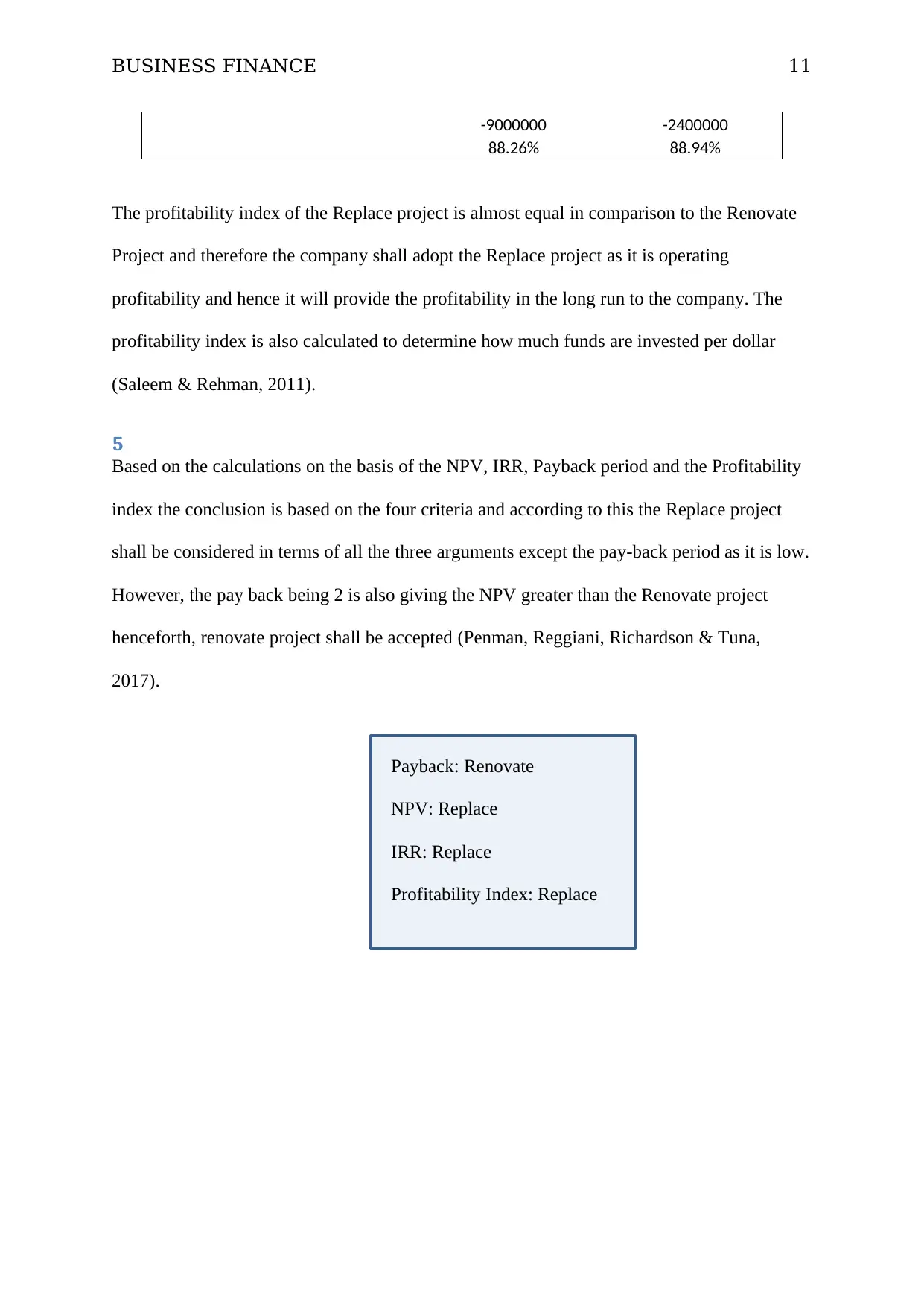
BUSINESS FINANCE 11
-9000000 -2400000
88.26% 88.94%
The profitability index of the Replace project is almost equal in comparison to the Renovate
Project and therefore the company shall adopt the Replace project as it is operating
profitability and hence it will provide the profitability in the long run to the company. The
profitability index is also calculated to determine how much funds are invested per dollar
(Saleem & Rehman, 2011).
5
Based on the calculations on the basis of the NPV, IRR, Payback period and the Profitability
index the conclusion is based on the four criteria and according to this the Replace project
shall be considered in terms of all the three arguments except the pay-back period as it is low.
However, the pay back being 2 is also giving the NPV greater than the Renovate project
henceforth, renovate project shall be accepted (Penman, Reggiani, Richardson & Tuna,
2017).
Payback: Renovate
NPV: Replace
IRR: Replace
Profitability Index: Replace
-9000000 -2400000
88.26% 88.94%
The profitability index of the Replace project is almost equal in comparison to the Renovate
Project and therefore the company shall adopt the Replace project as it is operating
profitability and hence it will provide the profitability in the long run to the company. The
profitability index is also calculated to determine how much funds are invested per dollar
(Saleem & Rehman, 2011).
5
Based on the calculations on the basis of the NPV, IRR, Payback period and the Profitability
index the conclusion is based on the four criteria and according to this the Replace project
shall be considered in terms of all the three arguments except the pay-back period as it is low.
However, the pay back being 2 is also giving the NPV greater than the Renovate project
henceforth, renovate project shall be accepted (Penman, Reggiani, Richardson & Tuna,
2017).
Payback: Renovate
NPV: Replace
IRR: Replace
Profitability Index: Replace
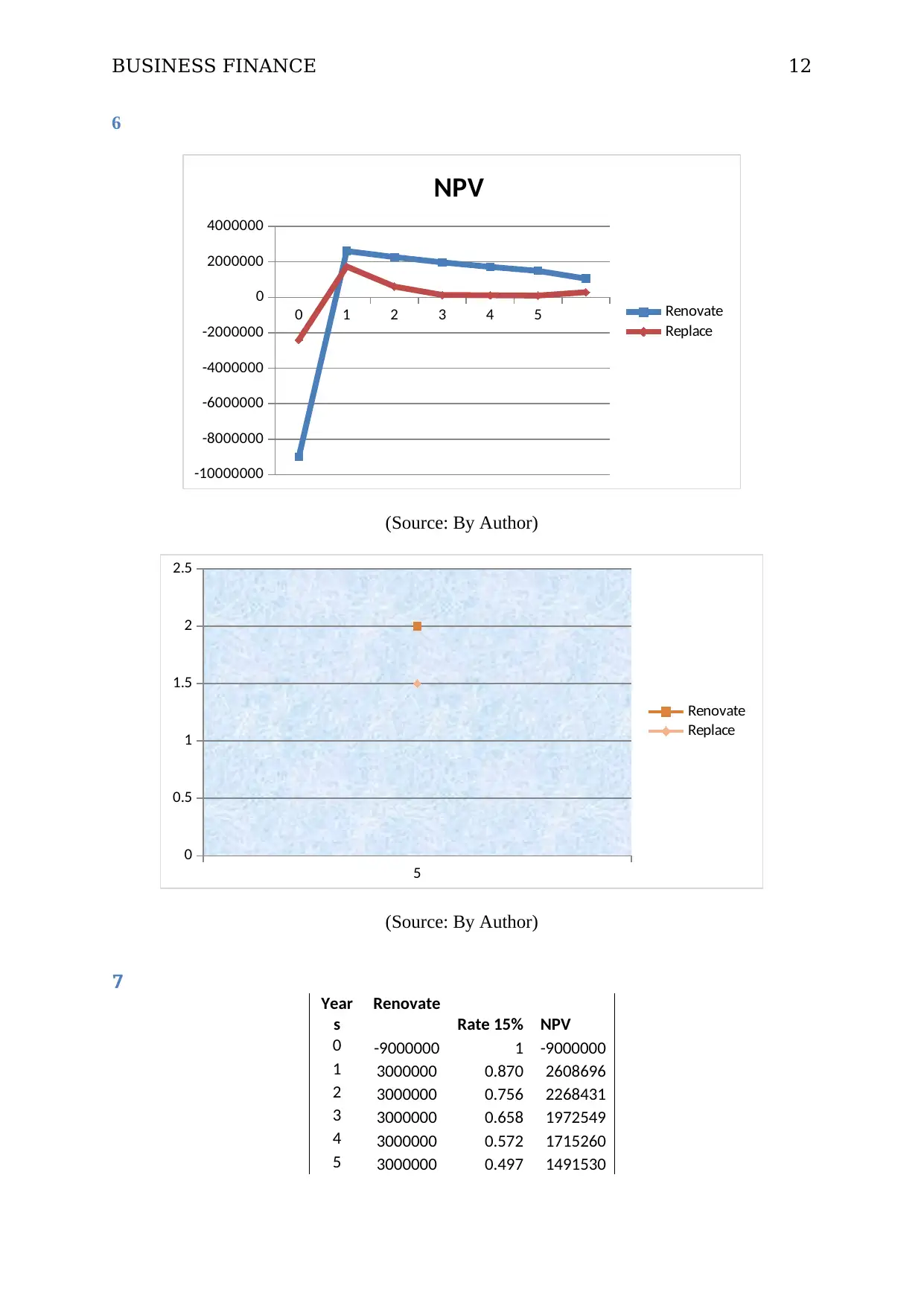
BUSINESS FINANCE 12
6
0 1 2 3 4 5
-10000000
-8000000
-6000000
-4000000
-2000000
0
2000000
4000000
NPV
Renovate
Replace
(Source: By Author)
5
0
0.5
1
1.5
2
2.5
Renovate
Replace
(Source: By Author)
7
Year
s
Renovate
Rate 15% NPV
0 -9000000 1 -9000000
1 3000000 0.870 2608696
2 3000000 0.756 2268431
3 3000000 0.658 1972549
4 3000000 0.572 1715260
5 3000000 0.497 1491530
6
0 1 2 3 4 5
-10000000
-8000000
-6000000
-4000000
-2000000
0
2000000
4000000
NPV
Renovate
Replace
(Source: By Author)
5
0
0.5
1
1.5
2
2.5
Renovate
Replace
(Source: By Author)
7
Year
s
Renovate
Rate 15% NPV
0 -9000000 1 -9000000
1 3000000 0.870 2608696
2 3000000 0.756 2268431
3 3000000 0.658 1972549
4 3000000 0.572 1715260
5 3000000 0.497 1491530
Paraphrase This Document
Need a fresh take? Get an instant paraphrase of this document with our AI Paraphraser
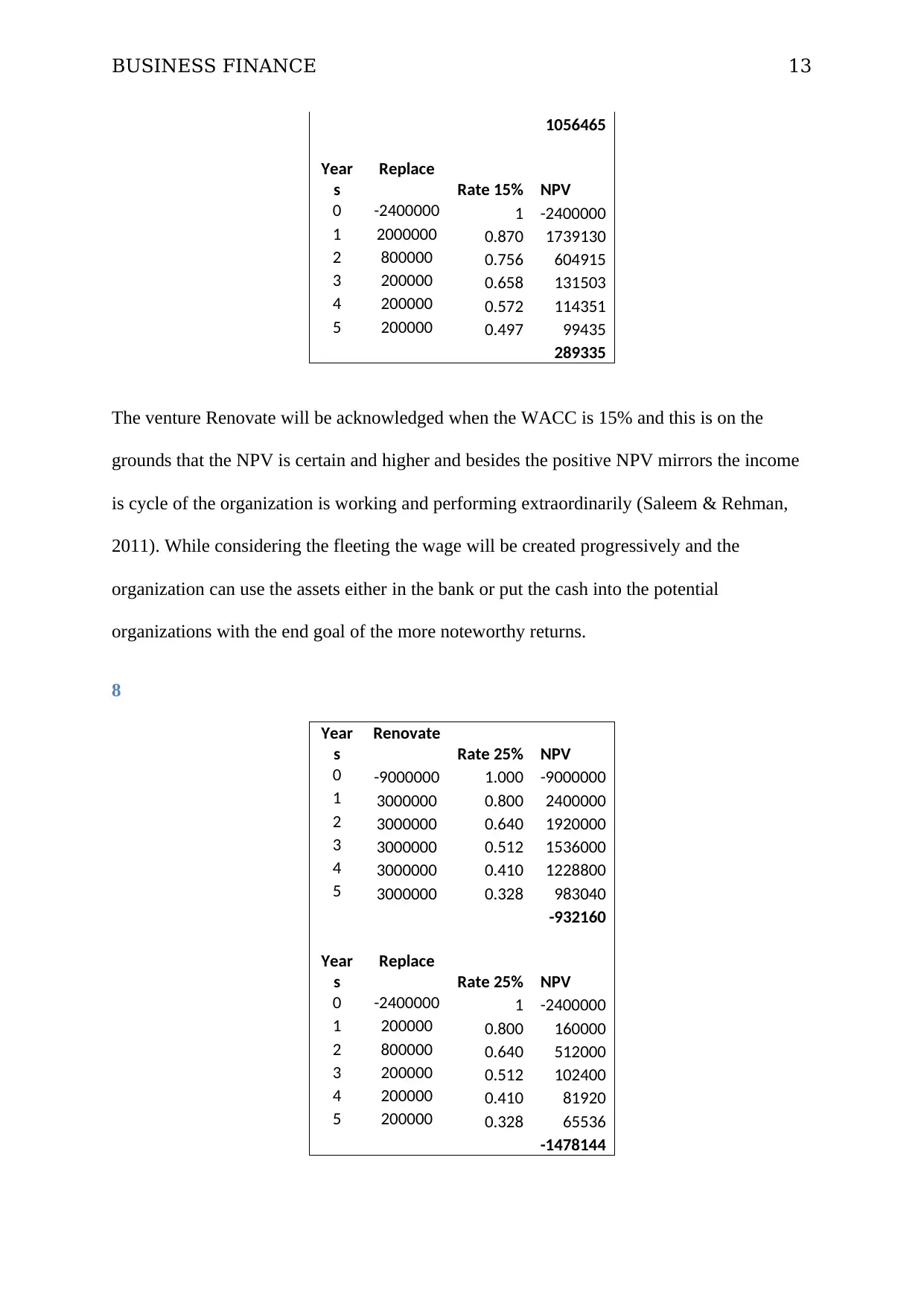
BUSINESS FINANCE 13
1056465
Year
s
Replace
Rate 15% NPV
0 -2400000 1 -2400000
1 2000000 0.870 1739130
2 800000 0.756 604915
3 200000 0.658 131503
4 200000 0.572 114351
5 200000 0.497 99435
289335
The venture Renovate will be acknowledged when the WACC is 15% and this is on the
grounds that the NPV is certain and higher and besides the positive NPV mirrors the income
is cycle of the organization is working and performing extraordinarily (Saleem & Rehman,
2011). While considering the fleeting the wage will be created progressively and the
organization can use the assets either in the bank or put the cash into the potential
organizations with the end goal of the more noteworthy returns.
8
Year
s
Renovate
Rate 25% NPV
0 -9000000 1.000 -9000000
1 3000000 0.800 2400000
2 3000000 0.640 1920000
3 3000000 0.512 1536000
4 3000000 0.410 1228800
5 3000000 0.328 983040
-932160
Year
s
Replace
Rate 25% NPV
0 -2400000 1 -2400000
1 200000 0.800 160000
2 800000 0.640 512000
3 200000 0.512 102400
4 200000 0.410 81920
5 200000 0.328 65536
-1478144
1056465
Year
s
Replace
Rate 15% NPV
0 -2400000 1 -2400000
1 2000000 0.870 1739130
2 800000 0.756 604915
3 200000 0.658 131503
4 200000 0.572 114351
5 200000 0.497 99435
289335
The venture Renovate will be acknowledged when the WACC is 15% and this is on the
grounds that the NPV is certain and higher and besides the positive NPV mirrors the income
is cycle of the organization is working and performing extraordinarily (Saleem & Rehman,
2011). While considering the fleeting the wage will be created progressively and the
organization can use the assets either in the bank or put the cash into the potential
organizations with the end goal of the more noteworthy returns.
8
Year
s
Renovate
Rate 25% NPV
0 -9000000 1.000 -9000000
1 3000000 0.800 2400000
2 3000000 0.640 1920000
3 3000000 0.512 1536000
4 3000000 0.410 1228800
5 3000000 0.328 983040
-932160
Year
s
Replace
Rate 25% NPV
0 -2400000 1 -2400000
1 200000 0.800 160000
2 800000 0.640 512000
3 200000 0.512 102400
4 200000 0.410 81920
5 200000 0.328 65536
-1478144
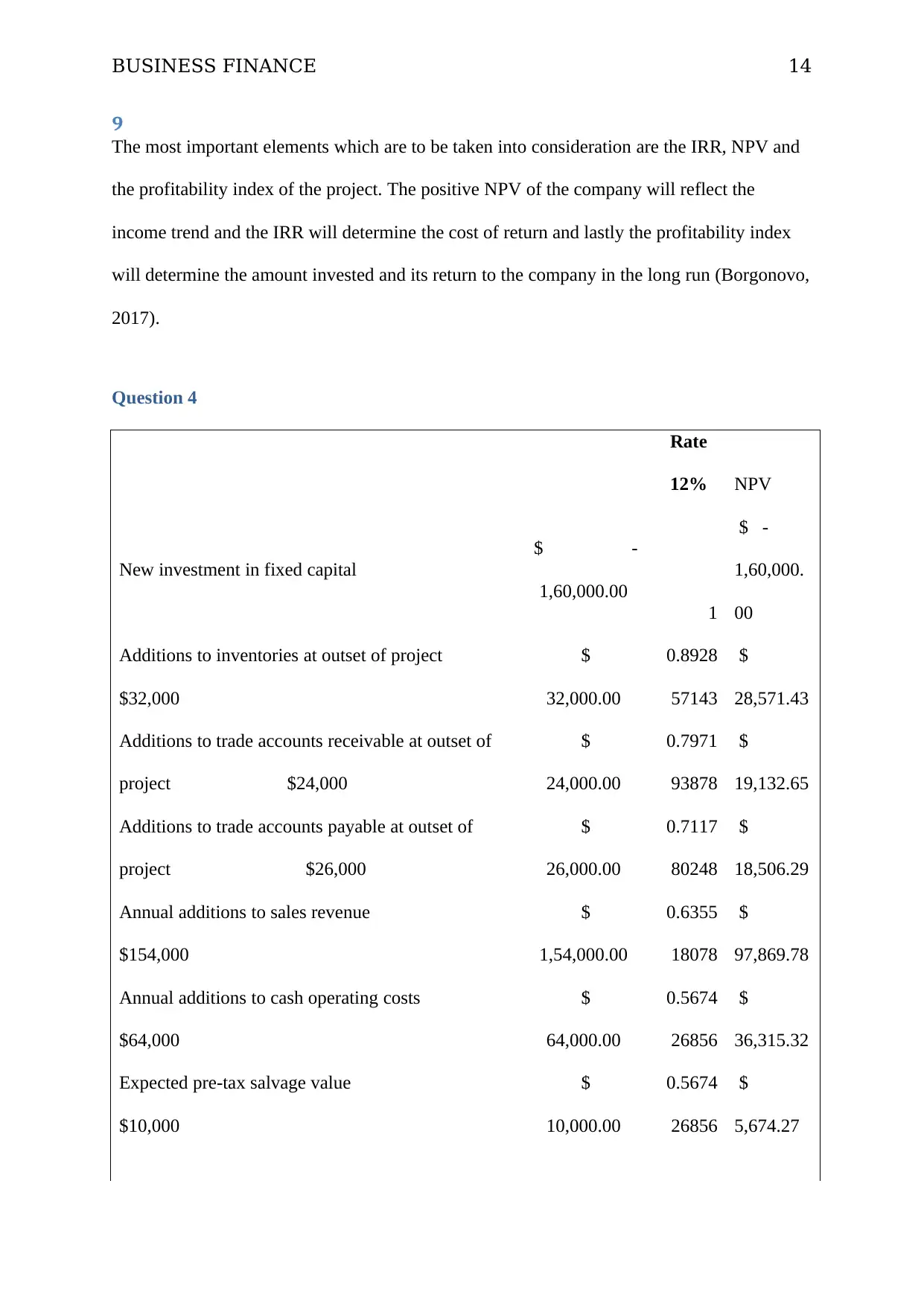
BUSINESS FINANCE 14
9
The most important elements which are to be taken into consideration are the IRR, NPV and
the profitability index of the project. The positive NPV of the company will reflect the
income trend and the IRR will determine the cost of return and lastly the profitability index
will determine the amount invested and its return to the company in the long run (Borgonovo,
2017).
Question 4
Rate
12% NPV
New investment in fixed capital
$ -
1,60,000.00
1
$ -
1,60,000.
00
Additions to inventories at outset of project
$32,000
$
32,000.00
0.8928
57143
$
28,571.43
Additions to trade accounts receivable at outset of
project $24,000
$
24,000.00
0.7971
93878
$
19,132.65
Additions to trade accounts payable at outset of
project $26,000
$
26,000.00
0.7117
80248
$
18,506.29
Annual additions to sales revenue
$154,000
$
1,54,000.00
0.6355
18078
$
97,869.78
Annual additions to cash operating costs
$64,000
$
64,000.00
0.5674
26856
$
36,315.32
Expected pre-tax salvage value
$10,000
$
10,000.00
0.5674
26856
$
5,674.27
9
The most important elements which are to be taken into consideration are the IRR, NPV and
the profitability index of the project. The positive NPV of the company will reflect the
income trend and the IRR will determine the cost of return and lastly the profitability index
will determine the amount invested and its return to the company in the long run (Borgonovo,
2017).
Question 4
Rate
12% NPV
New investment in fixed capital
$ -
1,60,000.00
1
$ -
1,60,000.
00
Additions to inventories at outset of project
$32,000
$
32,000.00
0.8928
57143
$
28,571.43
Additions to trade accounts receivable at outset of
project $24,000
$
24,000.00
0.7971
93878
$
19,132.65
Additions to trade accounts payable at outset of
project $26,000
$
26,000.00
0.7117
80248
$
18,506.29
Annual additions to sales revenue
$154,000
$
1,54,000.00
0.6355
18078
$
97,869.78
Annual additions to cash operating costs
$64,000
$
64,000.00
0.5674
26856
$
36,315.32
Expected pre-tax salvage value
$10,000
$
10,000.00
0.5674
26856
$
5,674.27
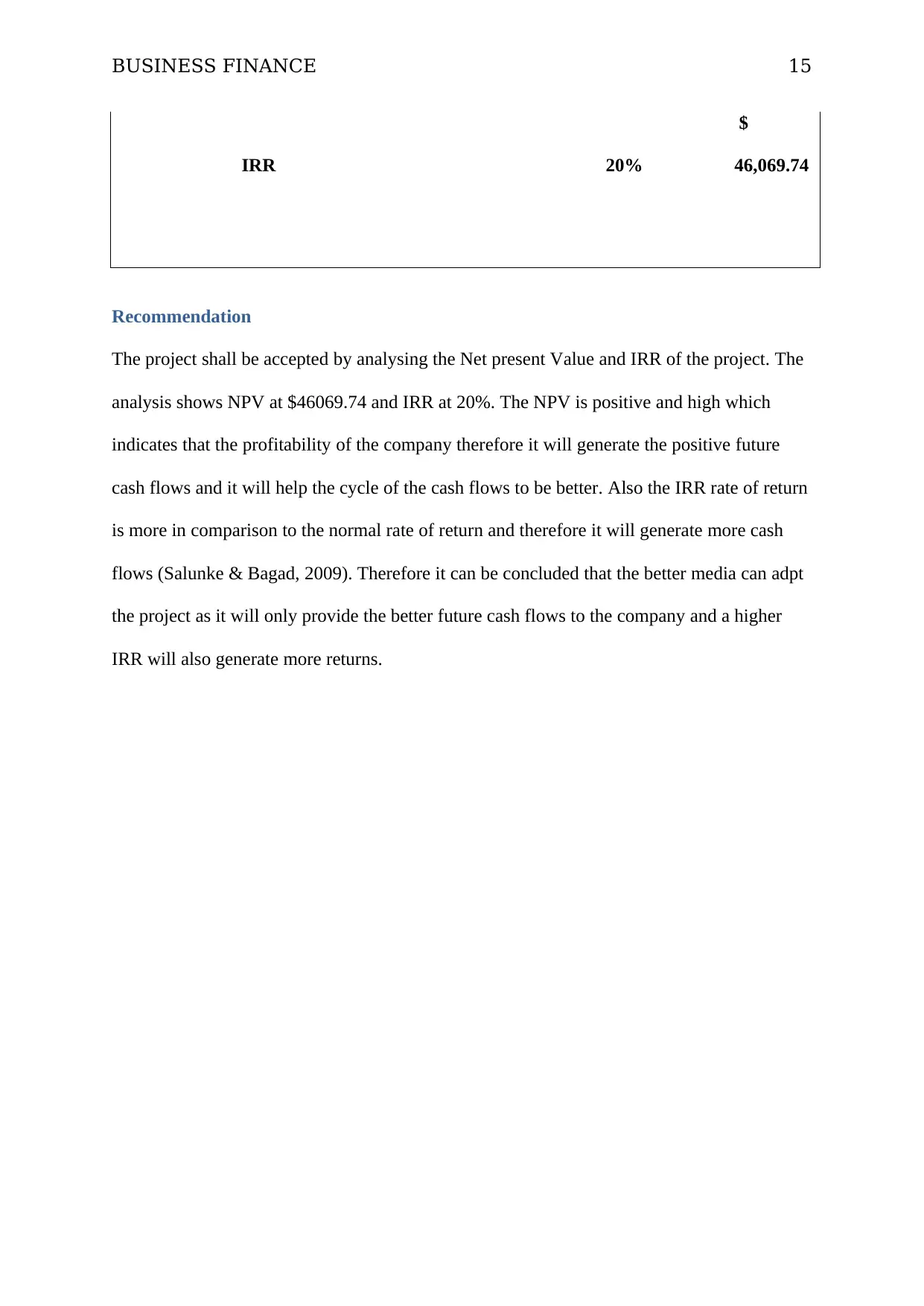
BUSINESS FINANCE 15
IRR 20%
$
46,069.74
Recommendation
The project shall be accepted by analysing the Net present Value and IRR of the project. The
analysis shows NPV at $46069.74 and IRR at 20%. The NPV is positive and high which
indicates that the profitability of the company therefore it will generate the positive future
cash flows and it will help the cycle of the cash flows to be better. Also the IRR rate of return
is more in comparison to the normal rate of return and therefore it will generate more cash
flows (Salunke & Bagad, 2009). Therefore it can be concluded that the better media can adpt
the project as it will only provide the better future cash flows to the company and a higher
IRR will also generate more returns.
IRR 20%
$
46,069.74
Recommendation
The project shall be accepted by analysing the Net present Value and IRR of the project. The
analysis shows NPV at $46069.74 and IRR at 20%. The NPV is positive and high which
indicates that the profitability of the company therefore it will generate the positive future
cash flows and it will help the cycle of the cash flows to be better. Also the IRR rate of return
is more in comparison to the normal rate of return and therefore it will generate more cash
flows (Salunke & Bagad, 2009). Therefore it can be concluded that the better media can adpt
the project as it will only provide the better future cash flows to the company and a higher
IRR will also generate more returns.
Secure Best Marks with AI Grader
Need help grading? Try our AI Grader for instant feedback on your assignments.
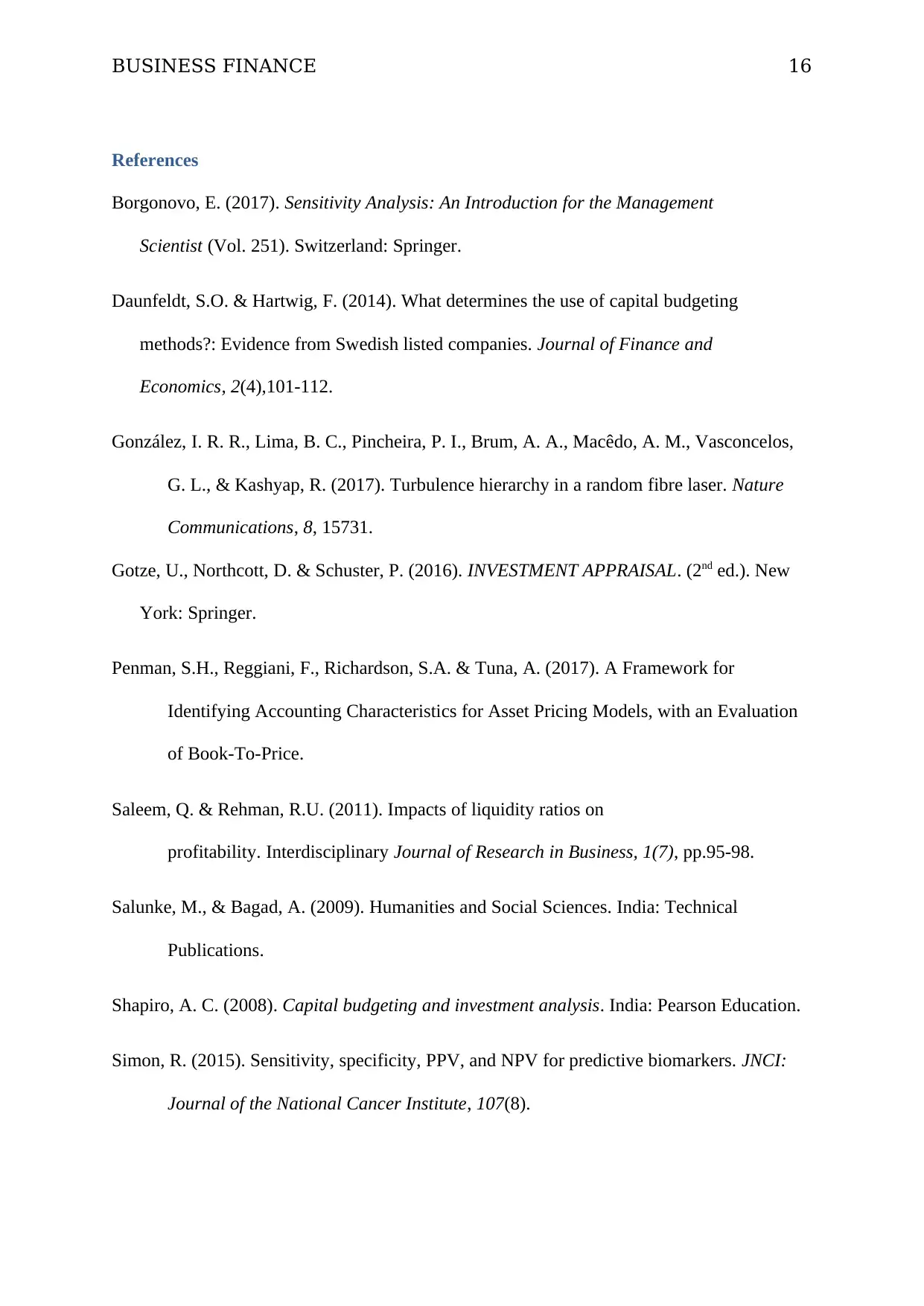
BUSINESS FINANCE 16
References
Borgonovo, E. (2017). Sensitivity Analysis: An Introduction for the Management
Scientist (Vol. 251). Switzerland: Springer.
Daunfeldt, S.O. & Hartwig, F. (2014). What determines the use of capital budgeting
methods?: Evidence from Swedish listed companies. Journal of Finance and
Economics, 2(4),101-112.
González, I. R. R., Lima, B. C., Pincheira, P. I., Brum, A. A., Macêdo, A. M., Vasconcelos,
G. L., & Kashyap, R. (2017). Turbulence hierarchy in a random fibre laser. Nature
Communications, 8, 15731.
Gotze, U., Northcott, D. & Schuster, P. (2016). INVESTMENT APPRAISAL. (2nd ed.). New
York: Springer.
Penman, S.H., Reggiani, F., Richardson, S.A. & Tuna, A. (2017). A Framework for
Identifying Accounting Characteristics for Asset Pricing Models, with an Evaluation
of Book-To-Price.
Saleem, Q. & Rehman, R.U. (2011). Impacts of liquidity ratios on
profitability. Interdisciplinary Journal of Research in Business, 1(7), pp.95-98.
Salunke, M., & Bagad, A. (2009). Humanities and Social Sciences. India: Technical
Publications.
Shapiro, A. C. (2008). Capital budgeting and investment analysis. India: Pearson Education.
Simon, R. (2015). Sensitivity, specificity, PPV, and NPV for predictive biomarkers. JNCI:
Journal of the National Cancer Institute, 107(8).
References
Borgonovo, E. (2017). Sensitivity Analysis: An Introduction for the Management
Scientist (Vol. 251). Switzerland: Springer.
Daunfeldt, S.O. & Hartwig, F. (2014). What determines the use of capital budgeting
methods?: Evidence from Swedish listed companies. Journal of Finance and
Economics, 2(4),101-112.
González, I. R. R., Lima, B. C., Pincheira, P. I., Brum, A. A., Macêdo, A. M., Vasconcelos,
G. L., & Kashyap, R. (2017). Turbulence hierarchy in a random fibre laser. Nature
Communications, 8, 15731.
Gotze, U., Northcott, D. & Schuster, P. (2016). INVESTMENT APPRAISAL. (2nd ed.). New
York: Springer.
Penman, S.H., Reggiani, F., Richardson, S.A. & Tuna, A. (2017). A Framework for
Identifying Accounting Characteristics for Asset Pricing Models, with an Evaluation
of Book-To-Price.
Saleem, Q. & Rehman, R.U. (2011). Impacts of liquidity ratios on
profitability. Interdisciplinary Journal of Research in Business, 1(7), pp.95-98.
Salunke, M., & Bagad, A. (2009). Humanities and Social Sciences. India: Technical
Publications.
Shapiro, A. C. (2008). Capital budgeting and investment analysis. India: Pearson Education.
Simon, R. (2015). Sensitivity, specificity, PPV, and NPV for predictive biomarkers. JNCI:
Journal of the National Cancer Institute, 107(8).
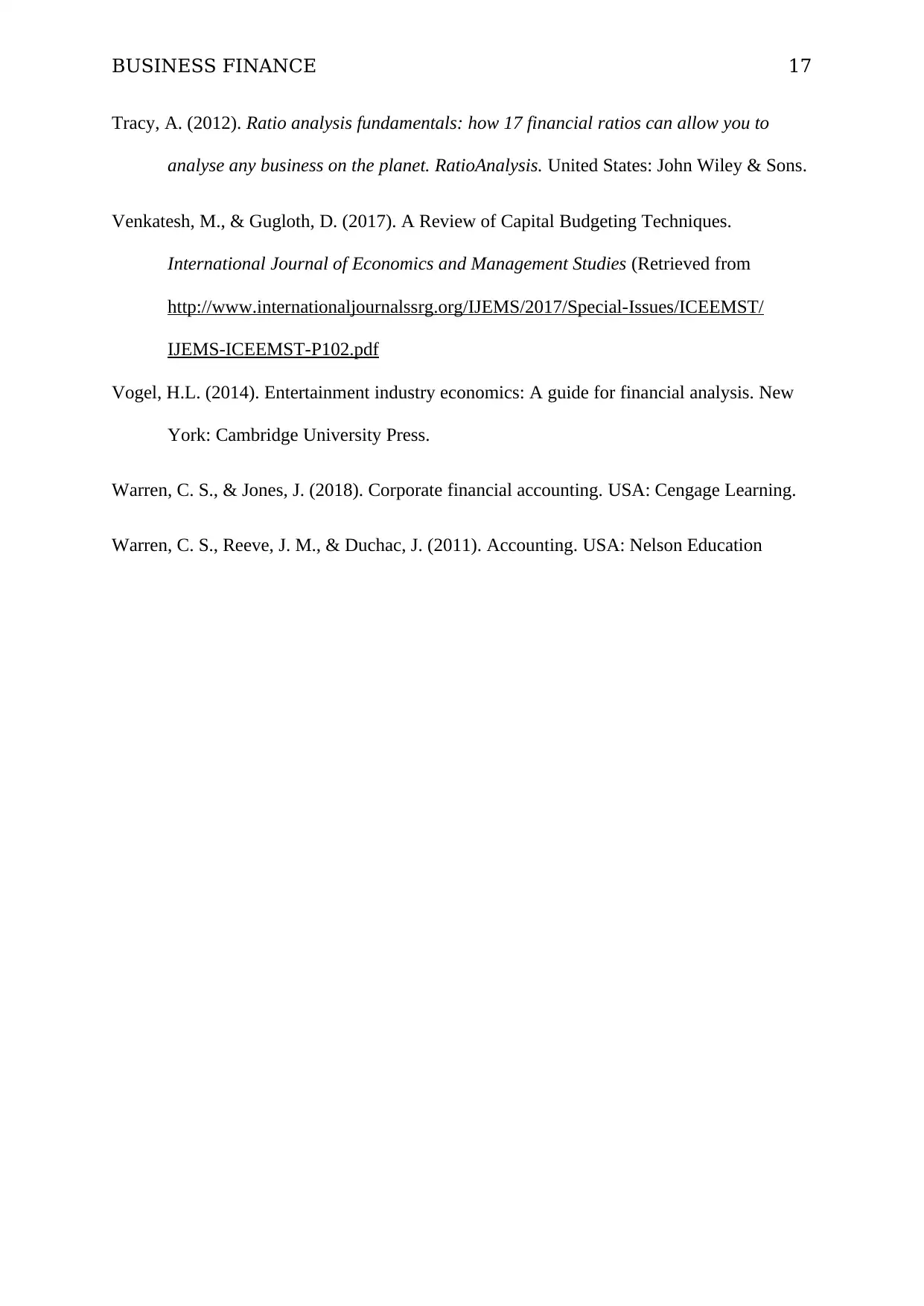
BUSINESS FINANCE 17
Tracy, A. (2012). Ratio analysis fundamentals: how 17 financial ratios can allow you to
analyse any business on the planet. RatioAnalysis. United States: John Wiley & Sons.
Venkatesh, M., & Gugloth, D. (2017). A Review of Capital Budgeting Techniques.
International Journal of Economics and Management Studies (Retrieved from
http://www.internationaljournalssrg.org/IJEMS/2017/Special-Issues/ICEEMST/
IJEMS-ICEEMST-P102.pdf
Vogel, H.L. (2014). Entertainment industry economics: A guide for financial analysis. New
York: Cambridge University Press.
Warren, C. S., & Jones, J. (2018). Corporate financial accounting. USA: Cengage Learning.
Warren, C. S., Reeve, J. M., & Duchac, J. (2011). Accounting. USA: Nelson Education
Tracy, A. (2012). Ratio analysis fundamentals: how 17 financial ratios can allow you to
analyse any business on the planet. RatioAnalysis. United States: John Wiley & Sons.
Venkatesh, M., & Gugloth, D. (2017). A Review of Capital Budgeting Techniques.
International Journal of Economics and Management Studies (Retrieved from
http://www.internationaljournalssrg.org/IJEMS/2017/Special-Issues/ICEEMST/
IJEMS-ICEEMST-P102.pdf
Vogel, H.L. (2014). Entertainment industry economics: A guide for financial analysis. New
York: Cambridge University Press.
Warren, C. S., & Jones, J. (2018). Corporate financial accounting. USA: Cengage Learning.
Warren, C. S., Reeve, J. M., & Duchac, J. (2011). Accounting. USA: Nelson Education
1 out of 18
Related Documents
Your All-in-One AI-Powered Toolkit for Academic Success.
+13062052269
info@desklib.com
Available 24*7 on WhatsApp / Email
![[object Object]](/_next/static/media/star-bottom.7253800d.svg)
Unlock your academic potential
© 2024 | Zucol Services PVT LTD | All rights reserved.




